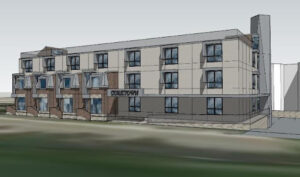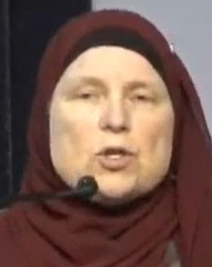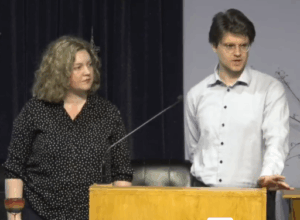An enthusiastic audience member came away from last Saturday’s Co-operative events convinced that co-op housing “is the best way to live,” especially for young families and seniors. The event drew relatively few people—about three dozen—but those who came heard lots about how co-op housing works, its benefits and some of the challenges and opportunities of building more.

Rental co-op housing has a legal structure in which tenants are members and have a vote on major decisions and to elect a board that manages the co-op. The co-op owns the land and buildings. It’s the only kind of housing Sarah Burnett-Murray has known. She’s lived in Hamilton co-ops since infancy and she’s so enthusiastic she’s been on her co-op board and its president, a director of the Golden Horseshoe Co-operative Housing Federation. She also managed co-ops for seven years and serves on the Co-operative Housing Federation of Canada education committee.
She remembers the co-op she grew up in as a community where members shared things, organized barbecues and work parties, and watched out for each other’s children.
“I grew up watching the parents come together and work together collectively for the betterment of the co-op. I watched them have votes over what colour to paint the hallway, because that was a big debate, let me tell you.” If someone needed help with something, people pitched in or raised money to help.

Getting new co-op units built takes time, Mary Margaret Kachurowski, manager of the Corktown Co-op, said. Her co-op is currently building 17 new units (see the drawing), at the end of a process that can take seven to nine years. The co-op received $2 million in grants and has a $9 million mortgage. She said the federal government provides funding based on rents at 80 per cent of average market rent, but that’s not affordable for someone earning minimum wage, even full-time, so there’s a need for subsidy to make units affordable. There is a pressing need for more co-op homes. At her co-op, people have been on the waitlist since 2014 and they may never get a unit.

Doug Sider, the executive director of the Golden Horseshoe Housing Co-operative Federation, was encouraged that the federal government, after a 30-year absence, has finally launched a co-op development fund, with a goal of building 6,000 units. There are 92,500 units now. He said we need to encourage the government to continue that funding and to expand it.

Kathy Dimassi, housing administrator of Halum Park Co-op on the Mountain, said the homes in her co-op were originally Wartime Housing units and had various owners over the following decades. In 1990, the residents learned that the buildings were being sold to two buyers who intended to bulldoze the units and rebuild. The residents managed to save their homes by forming a housing co-op and getting a $10 million loan to buy the units themselves. The loan came through a land trust, which provided the co-op with a 49-year lease on the land and buildings.
Dimassi also described the challenges the co-op faced trying to get support to add a 28-unit building, but couldn’t get government approval. With a grant from the city and very careful accumulation of operating savings, they were able to build eight units.

Jacob Hoytema and Emily Power recapped the story of how the tenants of a 21-unit building on Caroline South learned their landlord planned to sell their building, and how they managed to line up the financing from many sources to buy it themselves. Part of their strategy was to tell other would-be for-profit buyers that they would have to deal with a strong tenants’ association, which discouraged other offers. Emily noted that the city has created a $5 million pilot project to allow non-profit housing providers to buy existing for-profit apartment buildings with affordable rents to keep them affordable. Co-ops should be eligible to participate, she said, not just non-profits. Tenants should have the first right to buy their buildings.
Jake said now that the Caroline Street co-op is set up, it has access to funds to do repairs and improve energy efficiency. And the city has provided subsidies to lower the rent for 10 of the 21 units.
Both Jake and Emily encouraged tenants to form associations in their buildings now, to build relationships and be ready in case their landlords suddenly decide to sell.

Andy Broderick, of New Commons Development, a non-profit developer that works with non-profit builders, said the problem in housing is that it is treated as a financial asset for investors. As global communications improved over the past several decades, making it easier for profit-driven investors to move their money into options offering early and certain high returns, investors discovered housing as an asset class that generated higher profits than other investments available at the time. Investment money poured into buying housing, which pushed up prices. Also, only two provinces, Prince Edward Island and Manitoba, limit rent increases when a unit is vacated. In the other provinces, landlords can raise rents by any amount when a tenancy changes.
Broderick said only about 4 per cent of homes in Canada are non-profit or co-op housing. The average for Organization for Economic Co-operation and Development countries is 8 per cent, so we need to at least double our supply just to meet that average. The government doesn’t provide enough funding to meet all the needs, so he tries to create non-profit housing with the least debt and operating costsand suitable for residents of diverse income levels, so most of the rents are reasonable but below market and 30 to 40 per cent of the units could be for people with lower incomes who pay rents that don’t exceed 30 per cent of their income.